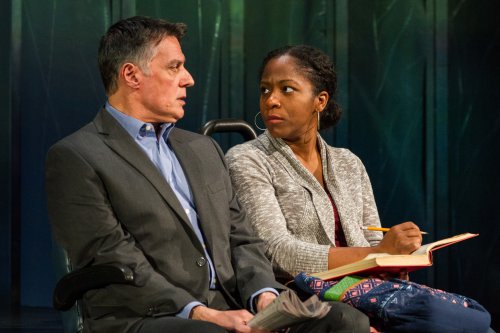White Guy on the Bus
While transcending its focus on Racism, this smart, powerful, shocking--yet moving--new play by Bruce Graham deserves and rewards your attention.

Robert Cuccioli and Danielle Leneé in a scene from “White Guy on the Bus” (Photo credit: Matt Urban/Mobius New Media Inc.)
[avatar user=”David Kaufman” size=”96″ align=”left”] David Kaufman, Critic[/avatar]Musical star Robert Cuccioli has to call upon his experience playing both Dr. Jekyll and Mr. Hyde to become Ray in White Guy on the Bus, a first-rate, new play by Bruce Graham, that has more than a stunning surprise or two, as it spreads out the story like a wild brush-fire burning out of control. His complicated and duplicitous “numbers man” character wants, from the beginning, to quit his high-paying job, and, like the French painter Gauguin, escape from the workaday world of banking and finance. “I don’t want to sell the house,” he tells his wife Roz in the opening scene. “I want to sell everything.”
A middle-aged, childless couple, Ray and Roz live in an upscale section of Philadelphia, with a swimming pool, hedges, and manicured lawn. Roz, on the other hand, teachers at an inner-city school in “North Philly” where, she says, the faculty has a betting pool each week on how many times she’s called a “white bitch.” “I think the record was like eighteen,” she adds. Roz is also particularly concerned about her student Nazir, who remains offstage, but nonetheless proves to be one of the most important figures in the story.
Despite any expectations to the contrary, Roz is deeply concerned with racism, wherever it may appear. As she soon explains, there’s both “real racism” and “perceived racism,” and later says, “Why did we ever fight the Civil War? This country would be so great without the South.” Early on, White Guy on the Bus may evoke–for theatergoers of a certain age–both To Sir, With Love and Up the Down Staircase, popular films of the mid-1960’s that concerned racism and socio-economic issues in public schools–but it ends up having far more dire consequences.

Jessica Bradford and Robert Cuccioli in a scene from “White Guy on the Bus” (Photo credit: Matt Urban/Mobius New Media Inc.)
Scene 2 introduces us to Christopher (Ray’s younger brother) and Molly, younger newlyweds, who are a foil to Ray and Roz, but equally bright, and almost like the children they never had. Ray will ultimately perform an act that is nothing less than paternal for the young couple.
However, after Ray (who, as indicated in a script note, is “always on stage”), the second most significant character in White Guy on the Bus is Shatique, an African-American nurse, working in “maternity,” as opposed to “geriatric,” nursing–“If I’m gonna’ change diapers I want it to be on babies,” she tells Ray. Shatique also has a son, who’s living with her own mother, in New Jersey, and a brother, who she visits in jail. Ray meets Shatique on the eponymous bus, which is where he sits next to her, again and again, before finally visiting her at her apartment. After learning that he has a Mercedes, Shatique wonders (just as we do) why Ray even rides “this damn bus” so often. The answer is part of what makes Graham’s complex and even brilliant play so very intriguing.
The White Guy on the Bus shuffles around in time even as the scene transitions melt into one another, each time with overlapping dialogue, with seamless results, thanks to Bud Martin’s sensitive and knowing direction. Though it includes an intermission between its two acts, it’s a breathless play that eventually takes your breath away. It also features Cuccioli giving a controlled yet effortless performance as the distressed and manipulative Ray, with hidden motives for all that he’s doing. The stalwart actor shifts from Ray’s anxiety to certainty without any signs of the hard work such transformations entail.

Susan McKey, Jessica Bedford, Robert Cuccioli and Jonathan Silver in a in a scene from “White Guy on the Bus” (Photo credit: Matt Urban/Mobius New Media Inc.)
Danielle Leneé proves equally impassioned as the duped Shatique, who is taken on an emotional roller coaster ride by Ray. Without giving away too much of the plot, after Ray tells Shatique that “Privacy has become extinct,” he adds that “Orwell was just a couple decades off,” which, considering the new technological developments that seem to be happening every week, is something we can all relate to.
Though they have smaller parts, Susan McKey (as Roz), Jessica Bedford (as Molly) and Jonathan Silver (as Christopher) all draw somewhat familiar characters without devolving into cliché. Rob Denton’s subtle lighting and Nicholas Hussong’s subdued projections contribute greatly to situating us, as the scenes travel at a fast clip, between Ray and Roz’s upscale home, to Molly and Christopher’s place in the city–not to mention, to the eponymous bus, and to Shatique’s apartment. Both Paul Tate DePoo III’s scenic and Wade Laboissonniere’s costume designs may be minimal, but they do their respective jobs effectively.
In the end, you can’t help but feel that playwright Graham has finally come into his own with White Guy on the Bus, and that this production deserves to move to a larger theater, where it can reach the much larger audience it warrants.
The White Guy on the Bus (through April 16, 2017)
Delaware Theatre Company
59E59 Theaters, 59 East 59th Street, in Manhattan
For tickets, call 212-279-4200 or visit http://www.59e59.org
Running time: two hours with one intermission






Leave a comment